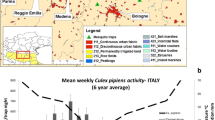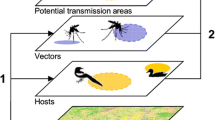Abstract
West Nile Virus (WNV) was first detected in the Texas equine population during June 2002. Infection has since spread rapidly across the state and become endemic in the equine population. Environmental risk factors associated with equine WNV attack rates in Texas counties during the period 2002 to 2004 were investigated. Equine WNV attack rates were smoothed using an empirical Bayesian model, because of the variability among county equine populations (range 46−9,517). Risk factors investigated included hydrological features (lakes, rivers, swamps, canals and river basins), land cover (tree, mosaic, shrub, herbaceous, cultivated and artificial), elevation, climate (rainfall and temperature), and reports of WNV-positive mosquito and wild bird samples. Estimated county equine WNV attack rate was best described by the number of lakes, presence of broadleaf deciduous forest, presence of cultivated areas, location within the Brazos River watershed, WNV-positive mosquito status and average temperature. An understanding of environmental factors that increase equine WNV disease risk can be used to design and target disease control programs.



Similar content being viewed by others
References
Anselin, L., 2005. Exploring Spatial Data with GeoDa™: A Workbook. University of Illinois, Urbana-Champaign. Available at http://sal.uiuc.edu/. Accessed 9 January 2008.
Apperson, C. S., Hassan, H. K., Harrison, B. A., Savage, H. M., Aspen, S. E., Farajollahi, A., Crans, W., Daniels, T. J., Falco, R. C., Benedict, M., Anderson, M., McMillen, L., Unnasch T. R., 2004. Host feeding patterns of established and potential mosquito vectors of West Nile virus in the Eastern United States. Vector Borne and Zoonotic Diseases, 4, 45–72. doi:10.1089/153036604773083013
Blitvich, B. J., Fernandez-Salas, I., Contreras-Cordero, J. F., Merlenee, N. L., Gonzalez- Rojas, J. I., Komar, N., Gubler, D. J., Calisher, C. H., Beaty B. J., 2003. Serologic evidence of West Nile virus infection in horses, Coahuila State, Mexico. Emerging Infectious Diseases, 9, 20–27.
Bolling, B. G., Kennedy, J. H., Zimmerman, G. E., 2005. Seasonal dynamics of four potential West Nile vectors in north central Texas. Journal of Vector Ecology, 30, 186–194.
Brownstein, J. S., Rosen, H., Prudy, D., Miller, J. R., Merlino, M., Mostashari, F., Fish, D., 2002. Spatial analysis of West Nile virus: rapid risk assessment of an introduced vector-borne zoonosis. Vector Borne and Zoonotic Diseases, 2, 252–271. doi:10.1089/15303660260613729
Castillo-Olivares J., Wood, J., 2004. West Nile virus infection of horses. Veterinary Research, 35, 467–483. doi:10.1051/vetres:2004022
Centers for Disease Control and Prevention, 2002. Provisional survelliance summary of the West Nile Virus epidemic – United States. Morbidity Mortality Weekly Reports, 51, 1129–1133.
Cooke, W. H. III, Grala, K., Wallis, R. C., 2006. Avian GIS models signal human risk for West Nile virus in Mississippi. International Journal of Health Geographics, 5, 36. doi:10.1186/1476-072X-5-36
Epstein, P. R., 2001. West Nile virus and the climate. Journal of Urban Health: Bulletin of the New York Academy of Medicine, 78, 201–208.
Gibbs, S. E. J., Wimberly, M. C., Madden, M., Masour, J., Yabsley, M. J., Stallknecht, D.E., 2006. Factors affecting the geographic distribution of West Nile virus in Georgia, USA: 2002−2004. Vector Borne and Zoonotic Diseases, 6, 73−82. doi:10.1089/vbz.2006.6.73
Hassan, A. N., Onsi, H. M., 2004. Remote sensing as a Tool for Mapping Mosquito Breeding Habitats and Associated Health Risk to Assist Control Efforts and Development Plans: A Case Study in Wadi El Natroun, Egypt. Journal of the Egyptian Society of Parasitology, 34, 367–382.
Hayes, C. G., 1988. West Nile fever. The arboviruses: epidemiology and ecology. Volume 1, number 2, pp. 59–88.
Hijmans, R. J., Cameron, S. E., Parra, J. L., Jones, P. G., Jarvis, A., 2005. Very high resolution interpolated climate surfaces for global land areas. International Journal of Climatology, 25, 1965−1978. doi:10.1002/joc.1276
Komar, N., 2002. West Nile virus: epidemiology and ecology in North America. Advances in Virus Research, 61, 185–234.
Kronenwetter-Koepel, T. A., 2005. Surveillance of above and below ground mosquito breeding habitats in rural midwestern community: baseline data for larvicidal control measures against WNV vectors. Clinical Medical Research, 3, 3–12.
Leblond, A., Zientara, S., Chadoeuf, J., Comby, N., Heng, M. A., Sabatier, P., 2005. Prevalence of West Nile Virus infection in horses in the Camargue area, South of France (2001). Revue de Medecine Veterinaire, 156, 77−84.
Leblond, A., Sandoz, A., Lefebvre, G., Zeller, H., Bicout, D. J., 2007. Remote sensing based identification of environmental risk factors associated with West Nile disease in horses in Camargue, France. Preventive Veterinary Medicine, 79, 20−31. doi:10.1016/j.prevetmed.2006.11.008
Molaei, G., Andreadis, T. G., 2006. Identification of avian- and mammalian-derived bloodmeals in Aedes vexans and Culiseta melanura (Diptera: Culicidae) and its implication for West Nile virus transmission in Connecticut, U.S.A. Journal of Medical Entomology, 43, 1088−1093. doi:10.1603/0022-2585(2006)43[1088:IOAAMB]2.0.CO;2
Mongoh, M. N., Khaitsa, M. L., Dyer, N. W., 2007. Environmental and ecological determinants of West Nile virus occurrence in horses in North Dakota, 2002. Epidemiology and Infection 135, 57−66. doi:10.1017/S0950268806006662
Ostlund, E.N., Andresen, J.E., Andresen, M., 2000. West Nile encephalitis. Veterinary Clinics of North America Equine Practice, 6, 427–441.
Paz, S, 2006. The West Nile Virus outbreak in Israel (2000) from a new perspective: the regional impact of climate change. International Journal of Environmental Health Research, 16, 2006. doi:10.1080/09603120500392400
Romi, R., Pontuale, G., Clufolini, M. G., Fiorentinin, G., Marchi, A., Nicoletti, L., Cocchi, M., Tamburro, A., 2004. Potential vectors of West Nile virus following and equine disease outbreak in Italy. Medical and Veterinary Entomology, 18, 202–224. doi:10.1111/j.1365-2915.2004.0478.x
Ruiz, M. O., Tedesco, C., McTighe, T. J., Austin, C., Kitron, U., 2004. Environmental and social determinants of human risk during a West Nile virus outbreak in the greater Chicago area, 2002. International Journal of Health Geographics, 3, 4–8. doi:10.1186/1476-072X-3-8
Ruiz, M. O., Walker, E. D., Foster, E. S., Haramis, L. D., Kitron, U. D., 2007. Association of West Nile virus illness and urban landscapes in Chicago and Detroit. International Journal of Health Geographics, 6, 10. doi:10.1186/1476-072X-6-10
Ward, M. P., 2005. Epidemic West Nile Virus encephalomyelitis: a temperature-dependent, spatial model of disease dynamics. Preventive Veterinary Medicine, 402 71, 253–264. doi:10.1016/j.prevetmed.2005.07.008
Ward, M. P., Carpenter, T. E., 2000. Techniques for analysis of disease clustering in space and in time in veterinary epidemiology. Preventive Veterinary Medicine, 45, 257–284. doi:10.1016/S0167-5877(00)00133-1
Acknowledgements
Funding for this study was provided to MPW by a grant from the Texas Equine Research Account Advisory Committee.
Author information
Authors and Affiliations
Corresponding author
Rights and permissions
About this article
Cite this article
Ward, M.P., Wittich, C.A., Fosgate, G. et al. Environmental risk factors for equine West Nile virus disease cases in Texas. Vet Res Commun 33, 461–471 (2009). https://doi.org/10.1007/s11259-008-9192-1
Received:
Accepted:
Published:
Issue Date:
DOI: https://doi.org/10.1007/s11259-008-9192-1




